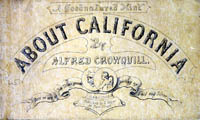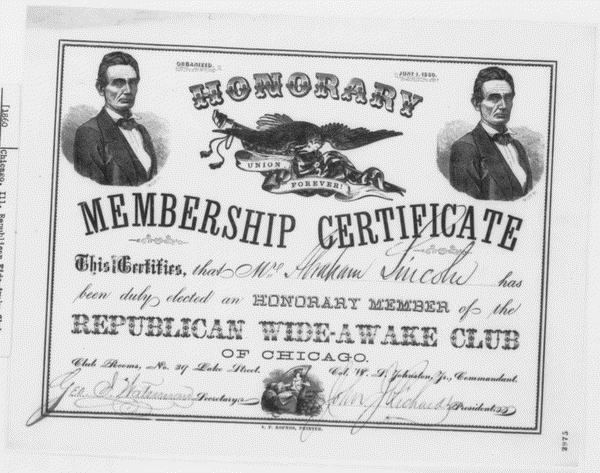 The Library of Congress provides a wealth of resources for teachers to use in the classroom. Most helpful are the themed Collection Connections, which seek to give historical context to the Library’s collections and assist teachers in using them in the classroom. One of these Collection Connections is on the Abraham Lincoln papers. In this section, documents by Abraham Lincoln have been selected for each of several categories. These resources are invaluable for anyone studying the life and times of Abraham Lincoln. One of the categories is Lincoln’s 1860 presidential campaign. There are four key documents included to illustrate this period of Lincoln’s life, including speech notes, campaign posters, and a letter. This selection of a few key documents serves to underscore the main themes and events of the campaign, and there are discussion questions included as well for teachers to use in the classroom. The page presents the information in a clear way but requires a critical reading of the texts as well. To help students further analyze the documents, there is a critical thinking page designed to give assistance with interpretation and analysis of events during Abraham Lincoln’s lifetime.
The Library of Congress provides a wealth of resources for teachers to use in the classroom. Most helpful are the themed Collection Connections, which seek to give historical context to the Library’s collections and assist teachers in using them in the classroom. One of these Collection Connections is on the Abraham Lincoln papers. In this section, documents by Abraham Lincoln have been selected for each of several categories. These resources are invaluable for anyone studying the life and times of Abraham Lincoln. One of the categories is Lincoln’s 1860 presidential campaign. There are four key documents included to illustrate this period of Lincoln’s life, including speech notes, campaign posters, and a letter. This selection of a few key documents serves to underscore the main themes and events of the campaign, and there are discussion questions included as well for teachers to use in the classroom. The page presents the information in a clear way but requires a critical reading of the texts as well. To help students further analyze the documents, there is a critical thinking page designed to give assistance with interpretation and analysis of events during Abraham Lincoln’s lifetime.
6
Apr
10
Abraham Lincoln in 1860 at the Library of Congress
Posted by Published in Antebellum (1840-1861), Images, Lesson Plans, Letters & Diaries Themes: Contests & Elections16
Mar
10
Two Communities during the Election of 1860
Posted by Published in 19th Century (1840-1880), Lesson Plans, Rare Books Themes: Contests & ElectionsWilliam G. Thomas III and Edward L. Ayers have a piece of digital scholarship entitled 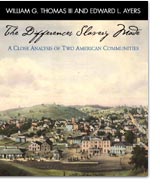 “The Differences Slavery Made: A Close Analysis of Two American Communities” that analyzes Augusta County, Virginia and Franklin County, Pennsylvania in the period just before the Civil War. While the scope of the article is to relate how slavery affected these two small communities, it contains some important analysis of the election of 1860 as well. The method follows closely that used by Ayers in his excellent book In the Presence of Mine Enemies. Analyzing primary documents from these two small towns close to the Mason-Dixon line sheds new light on previously held notions of how the buildup to the Civil War affected everyday Americans. Of particular interest in this article is the summary of Politics and the Election of 1860 and the “points of analysis” from these towns in the Campaign of 1860 and the Election of 1860. The digital format of this article makes it particularly compelling as the authors’ points about each county can be summarized briefly in a side-by-side manner, and then expanded upon by clicking the link if more information is needed. In this expanded view of the argument, there are links to all of the supporting evidence and historiography at the bottom.
“The Differences Slavery Made: A Close Analysis of Two American Communities” that analyzes Augusta County, Virginia and Franklin County, Pennsylvania in the period just before the Civil War. While the scope of the article is to relate how slavery affected these two small communities, it contains some important analysis of the election of 1860 as well. The method follows closely that used by Ayers in his excellent book In the Presence of Mine Enemies. Analyzing primary documents from these two small towns close to the Mason-Dixon line sheds new light on previously held notions of how the buildup to the Civil War affected everyday Americans. Of particular interest in this article is the summary of Politics and the Election of 1860 and the “points of analysis” from these towns in the Campaign of 1860 and the Election of 1860. The digital format of this article makes it particularly compelling as the authors’ points about each county can be summarized briefly in a side-by-side manner, and then expanded upon by clicking the link if more information is needed. In this expanded view of the argument, there are links to all of the supporting evidence and historiography at the bottom.
1
Mar
10
United States Colored Troops
Posted by Published in Civil War (1861-1865), Lesson Plans, Letters & Diaries Themes: Battles & Soldiers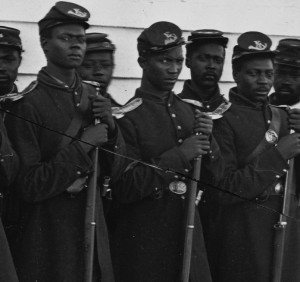 The National Archives has put together a great collection of materials highlighting the role that African-American soldiers played in the Civil War. Documents include letters highlighting the treatment of black prisoners of war by the Confederates, partial service records for Frederick Douglass’s sons, and partial service records for Sgt. William Carney, who received a Medal of Honor. No suggested grade levels were present on the website, so it is left up to individual teachers to create the level of difficulty appropriate for students.
The National Archives has put together a great collection of materials highlighting the role that African-American soldiers played in the Civil War. Documents include letters highlighting the treatment of black prisoners of war by the Confederates, partial service records for Frederick Douglass’s sons, and partial service records for Sgt. William Carney, who received a Medal of Honor. No suggested grade levels were present on the website, so it is left up to individual teachers to create the level of difficulty appropriate for students.
The activities included not only analyze the primary sources in terms of content with a provided worksheet, but ask students to synthesize and apply the information in one of four possible scenarios. Over all, the lesson activities are a bit weak when compared to the type of documents provided, yet under the heading ‘Further Research’ the lesson plan suggests students read and analyze Robert Lowell’s poem “Colonel Shaw and the Massachusetts’ 54th” (also known as “For the Union Dead,” available here) which is a great way to create an interdisciplinary lesson.
On the other hand, if one is looking for other ideas, the Civil War Preservation Trust offers a lesson plan on the United States Colored Troops, for grades six through eight. Using enlistment papers for a colored solider as well as two period illustrations, it guides teachers through several activities that ask students to describe, explain, and analyze information. The lesson plan is well thought out and can easily be supplemented with the documents made available by the National Archives.
8
Feb
10
HarpWeek Political Cartoons
Posted by Published in Antebellum (1840-1861), Images, Lesson Plans Themes: Contests & Elections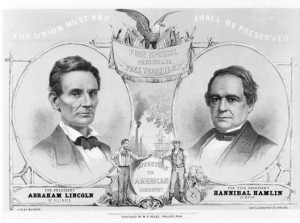 HarpWeek has an online collection of political cartoons from 14 presidential elections between the years 1860-1912. These cartoons provide a visual insight into the climate surrounding the Election of 1860, and its core issues. Some of the cartoons require a lot of prior historical knowledge, while others can be understood with some basic analysis. HarpWeek has convienently provided an analysis and explanation of each cartoon. There are other resources as well for the Election of 1860, including an overview of the historical context and a timeline of important events. Any of these political cartoons would be beneficial to a classroom discussion of this crucial election. This webpage provides a useful guide to using editorial cartoons in the classroom.
HarpWeek has an online collection of political cartoons from 14 presidential elections between the years 1860-1912. These cartoons provide a visual insight into the climate surrounding the Election of 1860, and its core issues. Some of the cartoons require a lot of prior historical knowledge, while others can be understood with some basic analysis. HarpWeek has convienently provided an analysis and explanation of each cartoon. There are other resources as well for the Election of 1860, including an overview of the historical context and a timeline of important events. Any of these political cartoons would be beneficial to a classroom discussion of this crucial election. This webpage provides a useful guide to using editorial cartoons in the classroom.
3
Feb
10
Help Improve the UGRR Digital Classroom
Posted by Matthew Pinsker Published in Antebellum (1840-1861), Images, Lesson Plans, Letters & Diaries Themes: Slavery & Abolition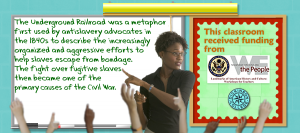 James McPherson writes in Battle Cry of Freedom (1989) that “On all issues but one, antebellum southerners stood for state’s rights and a weak federal government” (p. 78). Yet that one exception –the fugitive slave law– was a principal cause of the coming Civil War and potentially changes one’s view of the war’s meaning. White southerners were repeatedly infuriated by signs of northern resistance to the fugitive slave law. Abolitionists even taunted them by dubbing their efforts to help runaways an “Underground Railroad.” There was essentially a low-grade border war between North and South over this issue that lasted more than a decade and drove the conflict as much as the crisis over the western territories. Not everybody, not even McPherson, sees the impact of the Underground Railroad as looming this large during the antebellum period, but most of us at the House Divided Project do. That is why the first digital classroom we created was about the Underground Railroad. Partly funded by the NEH, this site offers a host of resources, including historic documents, images, interviews with leading scholars, Google Earth field trips, dozens of K-12 lesson plans and many more tools for the classroom. Especially since this is Black History Month, I hope readers of this blog post will use this opportunity to check out or reexamine these resources and post comments below offering feedback. Everything in the House Divided Project is still in what we are calling a draft edition –all can be fixed, improved or changed as we move toward a public launch during the Civil War 150th commemoration (2011-15).
James McPherson writes in Battle Cry of Freedom (1989) that “On all issues but one, antebellum southerners stood for state’s rights and a weak federal government” (p. 78). Yet that one exception –the fugitive slave law– was a principal cause of the coming Civil War and potentially changes one’s view of the war’s meaning. White southerners were repeatedly infuriated by signs of northern resistance to the fugitive slave law. Abolitionists even taunted them by dubbing their efforts to help runaways an “Underground Railroad.” There was essentially a low-grade border war between North and South over this issue that lasted more than a decade and drove the conflict as much as the crisis over the western territories. Not everybody, not even McPherson, sees the impact of the Underground Railroad as looming this large during the antebellum period, but most of us at the House Divided Project do. That is why the first digital classroom we created was about the Underground Railroad. Partly funded by the NEH, this site offers a host of resources, including historic documents, images, interviews with leading scholars, Google Earth field trips, dozens of K-12 lesson plans and many more tools for the classroom. Especially since this is Black History Month, I hope readers of this blog post will use this opportunity to check out or reexamine these resources and post comments below offering feedback. Everything in the House Divided Project is still in what we are calling a draft edition –all can be fixed, improved or changed as we move toward a public launch during the Civil War 150th commemoration (2011-15).
2
Feb
10
Worth a Thousand Words: Photographs of Lincoln
Posted by Published in Civil War (1861-1865), Images, Lesson Plans Themes: Laws & Litigation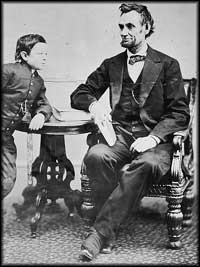 Written by Kaye Passmore and Amy Trenkle for the National Endowment for the Humanities, Picturing Lincoln is another Picturing America lesson plan. Using art as a medium to teach, students are asked to look at a photograph of Abraham Lincoln and make assessments. Later, students read a short biography of the president before exercising their creative skills in the forms of both poetry and artwork. The lesson plan is suggested for grades six through eight.
Written by Kaye Passmore and Amy Trenkle for the National Endowment for the Humanities, Picturing Lincoln is another Picturing America lesson plan. Using art as a medium to teach, students are asked to look at a photograph of Abraham Lincoln and make assessments. Later, students read a short biography of the president before exercising their creative skills in the forms of both poetry and artwork. The lesson plan is suggested for grades six through eight.
While the lesson plan offers an imaginative way for students to learn, one of the suggested extended activities, the interactive image assessment tool, allows students to become active learners. By clicking on various parts of Alexander Gardner’s February 5, 1865 photograph, students learn a fact before being encouraged to jot down any notes or questions they might have. While the activity is meant to be worked individually (with students emailing or printing out their responses), depending on individual class needs it could easily be adapted to be completed in small groups or as a whole.
16
Dec
09
John Bull and Uncle Sam
Posted by sailerd Published in 19th Century (1840-1880), Images, Lesson Plans Themes: Education & Culture, Settlers & Immigrants, Slavery & Abolition, US & the World“John Bull & Uncle Sam: Four Centuries of British-American Relations” is an interesting exhibit of selected items from the British Library in London and the Library of Congress in Washington DC. The site is organized around several themes, such as “Exploration and Settlement,” “Common Language, Separate Voices,” “From Abolition to Equal Rights,” and “Popular Culture: from Baseball to Rock and Roll.” The material related to the Civil War is spread out among these groups. Some particularly interesting items in this exhibit are a satire on the California Gold Rush (A Goodnatured Hint about California (London, 1849)), a political cartoon on Confederate diplomats’ failure to win recognition as an independent country from the United Kingdom, and a letter from Queen Victoria to Mary Lincoln after President Abraham Lincoln was assassinated.
24
Nov
09
Picturing America: Viewing the Civil War Through Art
Posted by Published in Civil War (1861-1865), Images, Lesson Plans Themes: Education & Culture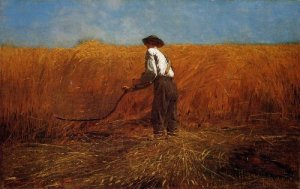
Picturing America, in an initiative funded by the National Endowment for the Humanities, brings examples from the many different genres of American art into the classroom. The program provides new and interesting pathways for students to understand American history. In addition to the resource book, the website also offers several additional resources for teachers looking to incorporate the program into their lesson plans.
One of the lesson plans available, “Homer’s Civil War Veteran: Battlefield to Wheat Field,” draws on both visual and written primary sources. Aimed at those in middle school (grades six through eight), the first activity has students compare and contrast Winslow Homer’s painting, The Veteran in a New Field, with Timothy O’Sullivan’s photograph, A Harvest of Death, Gettysburg 1863. The second has students read a selection from Civil War Captain James Wren’s diary concerning his experience at the Second Battle of Bull Run/Battle of Second Manassas. Finally, the third encourages students to make connections between all three activities, asking what the anonymous veteran in Homer’s painting might be thinking and why. The activities are easily adaptable to individual classroom needs and are creative enough to capture students’ interests.
12
Nov
09
Introducing Slavery through Slaves' Own Words
Posted by Published in Civil War (1861-1865), Lesson Plans, Letters & Diaries Themes: Slavery & Abolition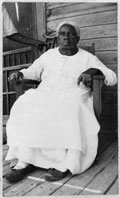 Approaching the topic of slavery can be difficult, especially at the elementary school level when these issues might be discussed for the first time. Posted by the National Endowment for the Humanities, “Slave Narratives: Constructing U.S. History Through Analyzing Primary Sources” offers a helpful classroom solution. Students from third to fifth grade read and explore a selection of narratives from the Federal Writers’ Project, after which they evaluate and respond to those sources.
Approaching the topic of slavery can be difficult, especially at the elementary school level when these issues might be discussed for the first time. Posted by the National Endowment for the Humanities, “Slave Narratives: Constructing U.S. History Through Analyzing Primary Sources” offers a helpful classroom solution. Students from third to fifth grade read and explore a selection of narratives from the Federal Writers’ Project, after which they evaluate and respond to those sources.
The lesson plan gives several strategies for teachers and the class to review and summarize the narratives in accordance to their needs. In addition, “Slave Narratives” introduces primary sources in the context of a story, before asking students to assess the veracity of the testimony. In a very real sense the students are “doing” history and hopefully fostering an interest at the same time.
11
Nov
09
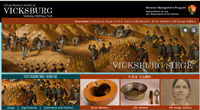
While one can always visit Vicksburg National Military Park, they also have a great exhibit online. Even those who have already been to the park should take a look. The site offers short essays on different aspects of the Vicksburg Siege as well as related images. In addition, the exhibit uses the U.S.S. Cairo as a way to teach visitors about river warfare. One can take a virtual tour of the U.S.S. Cairo as well as learn more about life aboard the ship. Teachers may want to check out the National Park Service’s “Teaching with Museum Collections” for several lesson plans that incorporate material in the Vicksburg exhibit.
